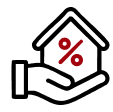Cash-Out Refinance Loans
Turn your home equity into cash with a cash-out refinance loan. Homeowners with sufficient equity can access funds for major expenses while potentially securing better interest rates than other financing options.
 Outstanding Client Experience
Outstanding Client Experience Specialized Lending Solutions
Specialized Lending Solutions Direct-to-Consumer Advantage
Direct-to-Consumer Advantage We're Advisors, NOT Salespeople
We're Advisors, NOT Salespeople Effortless Digital Mortgage Platform
Effortless Digital Mortgage PlatformTable of Contents
What Is a Cash-Out Refinance?
A cash-out refinance replaces your first home loan with a new, larger mortgage. You receive the difference between your new loan amount and your current mortgage balance as cash. This differs from a standard rate-and-term refinance, where you simply adjust your interest rate or loan duration without taking money out.
The mechanics are simple: when you refinance and cash out your equity, your lender pays off your current mortgage and creates a new one with different terms. Your home serves as collateral for the loan, which is why cash-out refinance rates tend to be lower than unsecured borrowing options like personal loans.
Several programs exist to meet different needs. Veterans and service members may qualify for a VA cash-out refinance with up to 100% of their home’s value. Meanwhile, FHA borrowers with less-than-perfect credit might consider an FHA cash-out refinance, which offers more lenient qualification standards than conventional loans up to 80% loan-to-value.
Why Get a Cash-Out Refinance Loan?
Homeowners choose cash-out refinance loans for numerous practical reasons, including:
- Debt consolidation: Combine high-interest debts into one lower-interest mortgage payment to potentially save thousands in interest charges over time.
- Funding home improvements/renovations: Improve your living space with renovations that can increase your property’s value and enhance your quality of life.
- Financing big purchases: Fund significant expenses like medical procedures, weddings, college, or other large costs at competitive interest rates.
- Covering business expenses: Invest in your business or startup using your home’s equity as relatively low-cost capital compared to commercial loans or credit cards.
- Down payment for another home/investment property: Access money for stock market investments, cryptocurrency, rental property purchases, or other wealth-building strategies when timing matters.
How Much Can You Borrow With a Cash-Out Refi?
Most conventional lenders cap cash-out refinance loans at 80% of your home’s appraised value. This maximum loan-to-value (LTV) ratio helps ensure you maintain a meaningful ownership stake in your property.
To illustrate, if your home is worth $350,000 and your remaining mortgage balance is $160,000, your maximum new loan would be $280,000 (80% of $350,000). After paying off the existing $160,000 mortgage, you could receive up to $120,000 in cash, minus closing costs.
Your borrowing power depends on several factors. Lenders evaluate your credit score, income stability, existing debt obligations, and property value to determine how much you qualify for. Most conventional cash-out refinance loans require a minimum credit score of 620, though requirements vary by lender and cash-out refi type.
Pros and Cons of a Cash-Out Refinance
Consider these benefits and drawbacks before proceeding with a cash-out refinance. Pros of a cash-out refinance include:
- Lower interest rates: Cash-out refinance loans generally offer more favorable rates than other unsecured financing options like personal loans or credit cards. This advantage can translate to significant savings over the life of the loan.
- Potential tax advantages: Interest paid on mortgage debt used for home improvements may be tax-deductible, unlike interest from most other forms of borrowing. This potential deduction effectively reduces your overall borrowing costs when you use the funds for qualifying renovations.
- Simplified finances: Replace multiple high-interest payments with one predictable monthly mortgage payment at a potentially lower rate. This consolidation can reduce financial stress and improve your monthly cash flow. Managing a single payment instead of multiple due dates also reduces the risk of missed payments that could damage your credit score.
- Improved home value: Using funds for strategic renovations can increase your property’s market value beyond the cost of improvements. This approach lets you leverage your existing equity to create additional equity, strengthening your overall financial position.
Potential downsides of a cash-out refinance are:
- Higher closing costs: Expect to pay between 2-5% of the total loan amount in fees and closing costs, which reduces your net cash.
- Foreclosure risk: Your home secures the loan, meaning you could lose your property if you fall behind on payments.
- Extended debt timeline: Refinancing often resets your loan term, which means you’ll take longer to pay off your home. To avoid this, you’ll want to ask your lender if they provide custom loan terms. For example, if you are 5 years into your 30-year fixed loan and don’t want to start over, see if a 25-year term is offered.
- Reduced equity: Taking cash from your home’s value decreases your ownership percentage, which could be problematic if you choose to sell or property values decline.
- Potential for a higher rate: You may be giving up an interest rate that is lower than the current prevailing market rate in order to pull cash out of the property, which may or may not make sense given your circumstances.
Cash-Out Refinance Alternatives
If a cash-out refinance doesn’t align with your needs, there are several alternatives you can consider, such as:
- Home equity loan: Borrow a fixed amount against your equity with a consistent interest rate and payment schedule while keeping your original mortgage intact. A home equity loan is a second mortgage that provides stability with predictable monthly payments. Many homeowners prefer this structure when they need a specific amount for a one-time expense.
- Home equity line of credit: Gain flexible access to funds as needed during a draw period, with variable interest rates applied only to the amount you use. The revolving line of credit structure allows you to borrow, repay, and borrow again during the draw period. This flexibility makes HELOCs ideal for ongoing projects with uncertain costs or as an emergency fund backup. Compare cash-out refinance vs HELOC to determine which option better suits your specific financial situation.
- Reverse mortgage: Convert home equity into income for homeowners 62 and older without monthly payments while continuing to live in your home. The loan becomes due only when you sell the home, permanently move out, or pass away. This option works well for seniors with significant home equity who need to supplement retirement income or cover healthcare expenses without the burden of monthly payments.
- Sell your home: If a cash-out refinance or a second mortgage doesn’t make financial sense then you may want to consider downsizing if you need cash without taking on additional payments.
See If You Qualify for a Cash-Out Refinance Loan
Tap into your home’s equity with competitive cash-out refinance rates when you work with Griffin Funding. We offer personalized service to help you make the best decisions about using your home’s value.
Our simple application process makes refinancing straightforward and fast. Use the Griffin Gold app to track your loan progress and communicate directly with your dedicated loan officer. Our mortgage expert will guide you through your options to find the solution that best supports your financial goals.
Get started online today and see how much you can get with a cash-out refinance loan.










